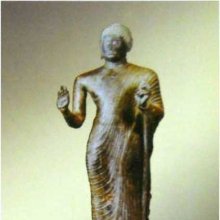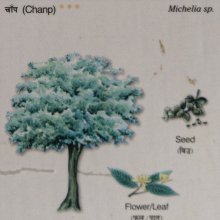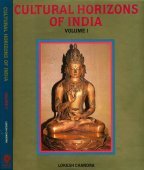Champa, Champā: 5 definitions
Introduction:
Champa means something in Hinduism, Sanskrit, the history of ancient India, biology. If you want to know the exact meaning, history, etymology or English translation of this term then check out the descriptions on this page. Add your comment or reference to a book if you want to contribute to this summary article.
Images (photo gallery)
In Hinduism
Shaiva philosophy
Source: Google Books: The Recognition SutrasThe country of Champa (coastal Vietnam) in ancient times used to a Tantrik kingdom, similair to the Kashmir valley, from which originated many Sanskrit scriptures, such as the 11th century Pratyabhijñāhṛdaya.—In the time of Kṣemarāja, Kashmir was a Tantrik kingdom, which means the rulers were (usually) Tantrik initiates who generously patronized the tradition—and therefore indirectly made possible this book! At that time there were many Tantrik kingdoms in the Asian world, such as those of Bali, Champa (coastal Vietnam), Angkor Wat (in Cambodia), and Tibet, and many more in India, Nepal, and what is now Pakistan. Until just a few years ago Nepal was a Tantrik kingdom, and nearby Bhutan is the last of the Tantrik kingdoms existing today.
-
General definition (in Hinduism)
Source: WikiPedia: HinduismChampā (चम्पा): A city on banks of the Ganges river where Karna found as a babe by Adhiratha and Rādhā
India history and geography
Source: Shodhganga: New look on the kushan bengaliChampa, near Bhagalpur in Bihar is situated on the confluence of river the Ganga and the Champa. The excavation here has brought to light interesting evidence regarding the antiquity of this city which goes back to 3rd century B.C or much earlier (IAR 1971- 72). Due to limited nature of excavations, details are not available but whatever material has been brought to light suggest it to be a flourishing town during the Kushan period. Brick structures, red wares, terracotta and stone beads were unearthed from the Kushan levels here. (Sinha, 1979)

The history of India traces the identification of countries, villages, towns and other regions of India, as well as mythology, zoology, royal dynasties, rulers, tribes, local festivities and traditions and regional languages. Ancient India enjoyed religious freedom and encourages the path of Dharma, a concept common to Buddhism, Hinduism, and Jainism.
Biology (plants and animals)
Source: Wisdom Library: Local Names of Plants and DrugsChampa [চম্পা] in the Bengali language is the name of a plant identified with Magnolia champaca (L.) Baill. ex Pierre from the Magnoliaceae (Magnolia) family having the following synonyms: Michelia champaca, Michelia rheedei, Champaca michelia. For the possible medicinal usage of champa, you can check this page for potential sources and references, although be aware that any some or none of the side-effects may not be mentioned here, wether they be harmful or beneficial to health.
Champa [चम्पा] in the Hindi language, ibid. previous identification.
Champa [چمپا] in the Urdu language, ibid. previous identification.
Champa [चम्पा] in the Nepali language, ibid. previous identification.
Champa [चम्पा, गुलाचिन] in the Hindi language is the name of a plant identified with Plumeria rubra Plumeria rubra L. from the Apocynaceae (Oleander) family having the following synonyms: Plumeria acutifolia, Plumeria rubra var. acutifolia.
Champa [চম্পা] in the Bengali language is the name of a plant identified with Magnolia x alba (DC.) Figlar from the Magnoliaceae (Magnolia) family having the following synonyms: Michelia alba.
Champa [चम्पा] in the Hindi language, ibid. previous identification.
Champa in the Marathi language, ibid. previous identification.
Champa [چمپا] in the Urdu language, ibid. previous identification.
Champa [चम्पा] in the Hindi language is the name of a plant identified with Plumeria obtusa L. from the Apocynaceae (Oleander) family having the following synonyms: Plumeria nivea, Plumeria emarginata.
Source: Google Books: CRC World Dictionary (Regional names)1) Champa in India is the name of a plant defined with Artocarpus integrifolius in various botanical sources. This page contains potential references in Ayurveda, modern medicine, and other folk traditions or local practices It has the synonym Artocarpus integrifolia L.f..
2) Champa is also identified with Jasminum officinale It has the synonym Jasminum officinale var. tenuifolium Stokes (etc.).
3) Champa is also identified with Michelia champaca It has the synonym Sampacca suaveolens (Pers.) Kuntze (etc.).
4) Champa is also identified with Ochna obtusata.
5) Champa is also identified with Ochna pumila.
6) Champa is also identified with Plumeria alba It has the synonym Plumeria alba Kunth (etc.).
7) Champa in South America is also identified with Campomanesia lineatifolia It has the synonym Psidium rivulare Mart. ex DC. (etc.).
Example references for further research on medicinal uses or toxicity (see latin names for full list):
· Mant. Pl. (1767)
· Systema Vegetabilium Florae Peruvianae et Chilensis (1798)
· Revisio Generum Plantarum (1891)
· Bijdragen tot de flora van Nederlandsch Indië (1825)
· Prodromus Systematis Naturalis Regni Vegetabilis (1828)
· Plantae Asiaticae Rariores, or ‘Descriptions and figures of a select number of unpublished East Indian plants’ (Wallich) (1831)
If you are looking for specific details regarding Champa, for example side effects, chemical composition, extract dosage, diet and recipes, health benefits, pregnancy safety, have a look at these references.

This sections includes definitions from the five kingdoms of living things: Animals, Plants, Fungi, Protists and Monera. It will include both the official binomial nomenclature (scientific names usually in Latin) as well as regional spellings and variants.
See also (Relevant definitions)
Starts with (+25): Champa baha, Champa methi, Champaa, Champaca, Champacam, Champada, Champadasa, Champadhipa, Champadka, Champai, Champak, Champaka, Champaka-shreshthikathanaka, Champakachaturdashi, Champakakusuma, Champakalu, Champakam, Champakamala, Champakapushpa, Champakapushpam.
Ends with (+107): Anna-tanacampa, Anumantaccampa, Aranaiccampa, Arikkancampa, Ban-champa, Ben-champa, Bhui champa, Bhui-champa, Bhuichampa, Bhuin-champa, Bhumi champa, Bhumi-champa, Bhumichampa, Bhuyichampa, Booichampa, Cannaccampa, Carappaliccampa, Cataiccampa, Cem-pavalacampa, Cemalaiccampa.
Full-text (+108): Campila, Campapuri, Campopalakshita, Kanak-champa, Sonacampa, Hari-champa, Lomapadapuri, Campaka, Campavati, Kanthali champa, Champa baha, Pila champa, Yellow champa, Khair champa, Kanako champa, Katha-champa, Kanack champa, Lal champa, Bhumi champa, Sultanah-champa.
Relevant text
Search found 29 books and stories containing Champa, Chaṃpā, Champā, Chāmpa; (plurals include: Champas, Chaṃpās, Champās, Chāmpas). You can also click to the full overview containing English textual excerpts. Below are direct links for the most relevant articles:
Vastu-shastra (5): Temple Architecture (by D. N. Shukla)
Temple architecture in Champa (central and southern Vietnam) < [Chapter 12 - History of Hindu Temples (Prāsādas and Vimānas)]
Temple architecture in Cambodia < [Chapter 12 - History of Hindu Temples (Prāsādas and Vimānas)]
Buddhist records of the Western world (Xuanzang) (by Samuel Beal)
Chapter 2 - Country of Chen-po (Champa) < [Book X - Seventeen Countries]
Chapter 3 - Country of Kie-chu-hoh-khi-lo (Kajughira or Kajingarha) < [Book X - Seventeen Countries]
Chapter 1 - Country of I-lan-na-po-fa-to (Hiranyaparvata) < [Book X - Seventeen Countries]
The Sky Lamp < [October – December, 1985]
The Gardener < [December 1943]
The Ramayana and Valmiki Abroad < [July-August 1931]
Vietnamese Buddhist Art (by Nguyen Ngoc Vinh)
1. History of Champa < [Chapter 2 - Similarity of Buddhist monuments in South Vietnam and South East Asia]
2. Avalokitesvara images in Champa < [Chapter 3 - Unifying factors of the Avalokitesvara Images in South Vietnam and South East Asia]
5. Buddhist monuments in Champa < [Chapter 2 - Similarity of Buddhist monuments in South Vietnam and South East Asia]
Kathasaritsagara (the Ocean of Story) (by Somadeva)
Vetāla 9: Anaṅgarati and her Four Suitors < [Appendix 6.1 - The Twenty-five Tales of a Vetāla]
Note on mounting giant birds < [Notes]
The Vishnu Purana (by Horace Hayman Wilson)
Related products


